Petra Jordan: The Lost City of Sand and Stone
Nestled amidst the rugged desert landscapes of Jordan sits an ancient city that has stood the test of time: Petra. Known as the "Lost City", Petra's beauty and mystique have captivated travellers and historians alike for centuries. With its towering sandstone cliffs and intriguing carvings, it remains one of the world's most breathtaking archaeological sites. For those who seek adventure and a glimpse into the ancient world, Petra is a destination that promises to leave an indelible mark on anyone who walks its dusty paths.
Come with me as we explore the wonders of Petra and discover the stories that have been etched in its sand and stone.

Introduction
Brief History of Petra Jordan
Petra, Jordan, originally known as Raqmu, is a historical and archaeological city in southern Jordan. This magnificent city is carved into vibrant red, white, pink, and sandstone cliff faces. It was once a thriving trading centre and the capital of the Nabataean empire between 400 B.C. and A.D. 106. However, it remained lost to the Western world for hundreds of years until a European traveller rediscovered it in the early 1800s.
Today, Petra symbolises Jordan and is the country's most-visited tourist attraction. Its stunning architectural wonders, including the Treasury, the Monastery, the Royal Tombs, and the High Place of Sacrifice, never fail to awe visitors worldwide. The city's rich history and breathtaking beauty make Petra an absolute must-visit destination. [1][2]
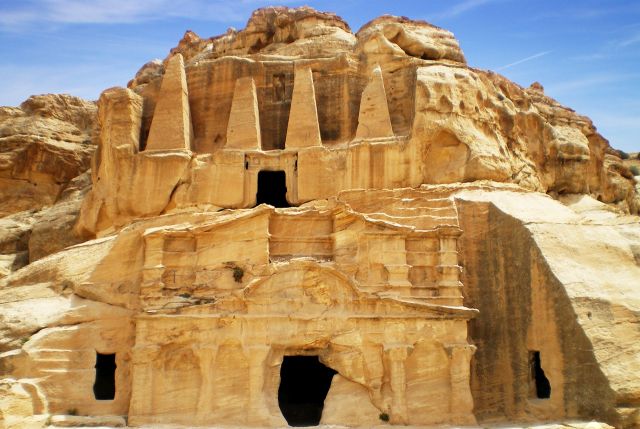
Importance of Petra Jordan
Petra, Jordan, holds immense significance both historically and culturally. This ancient city, with its breathtaking rock-cut architecture and vibrant stone buildings, is a testament to the ingenuity and skills of the Nabataeans.
It served as a major trading centre in the region, connecting routes from the Red Sea to the Mediterranean. The water conduit system developed by the Nabataeans was a marvel of engineering and allowed the city to prosper in an otherwise arid environment.
Today, Petra is recognised as a UNESCO World Heritage Site and is Jordan's most visited tourist attraction. Its majestic Treasury, Monastery, Royal Tombs, and High Place of Sacrifice continue to captivate visitors worldwide.
Whether you're a history enthusiast, an architecture lover, or simply seeking a unique travel experience, Petra, Jordan, is a must-visit destination that will leave you awe-inspired. [3][4]

Preview of the blog
In this blog post, we will explore the fascinating city of Petra, Jordan, known as the "Lost City of Sand and Stone." We will delve into its rich history, from its ancient origins to its rediscovery in the 19th century. You will learn about the legends surrounding Petra, the significance of this archaeological marvel, and how it has been featured in popular culture.
Next, we will guide you through the must-see attractions within the city, including the iconic Treasury, the magnificent Monastery, the royal tombs, and the High Place of Sacrifice. We will provide various transportation options for getting to Petra, whether by air, car, or bus. Additionally, we will provide information on budget accommodations and weather conditions to help you plan your visit.
Stay tuned for an exciting and informative journey into the hidden wonders of Petra, Jordan. [5][6]

The Discovery of Petra Jordan
The Legend of Petra Jordan
The legend of Petra, Jordan, is as captivating as the city. Carved into vibrant red, white, pink, and sandstone cliff faces, Petra was once a thriving trading centre and the capital of the Nabataean empire between 400 B.C. and A.D. 106. However, the city was lost to the Western world for hundreds of years, only to be rediscovered by a European traveller in the early 1800s.
Today, Petra stands as a testament to the ancient world's remarkable rock-cut architecture and water conduit system. Its famous Treasury, Monastery, Royal Tombs, and High Place of Sacrifice are just some remarkable sites waiting to be explored. Known as the Rose City because of the colour of the stone from which it is carved, Petra continues to capture the imagination of visitors from around the globe. [7][8]

The discovery of Petra Jordan
The discovery of Petra, Jordan, is a fascinating tale that adds to the allure of this ancient city. For hundreds of years, Petra was lost to the Western world, only known in local legends and myths.
It wasn't until the early 1800s that a European traveller, disguised in Bedouin costume, infiltrated this mysterious locale. This daring expedition brought Petra back into the spotlight and led to further exploration and excavation of the site.
In 1985, the Petra Archaeological Park was established, and in 2007, Petra was named one of the world's new seven wonders. Today, tourists from around the globe visit this historic city to witness its spectacular architecture and learn about its rich history.
The discovery of Petra, Jordan, is a testament to the power of exploration and the preservation of cultural heritage. [9][10]
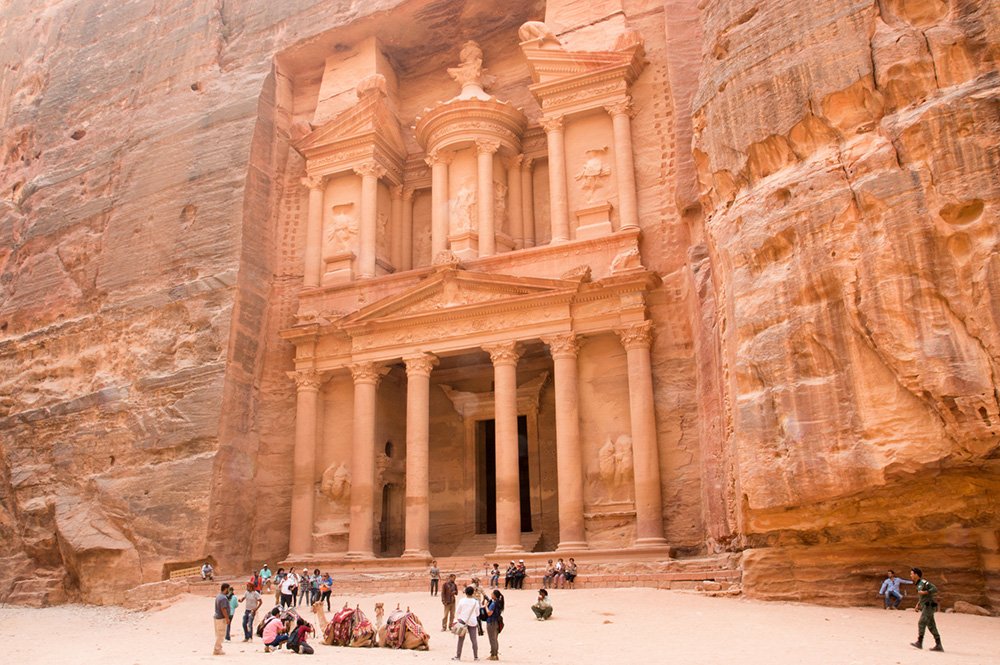
Petra Jordan Today
Petra, the ancient city carved into vibrant sandstone cliffs, continues to captivate visitors worldwide today. Designated as a UNESCO World Heritage Site, Petra is a symbol of Jordan and its most visited tourist attraction. The city's rock-cut architecture, including iconic structures like The Treasury, The Monastery, The Royal Tombs, and The High Place of Sacrifice, showcase the exceptional craftsmanship of the Nabataeans.
Getting to Petra is relatively easy, with various transportation options available. Visitors can arrive by air, car or bus, depending on their preferences and travel plans. Once in Petra, budget accommodations are available, allowing travellers to enjoy the city's wonders without breaking the bank.
Petra's unique history and impressive structures make it a must-visit destination for history enthusiasts and adventure seekers. Exploring this lost city of sand and stone is like stepping back in time, offering a glimpse into a bygone era of remarkable civilisation and architectural brilliance. [11][12]
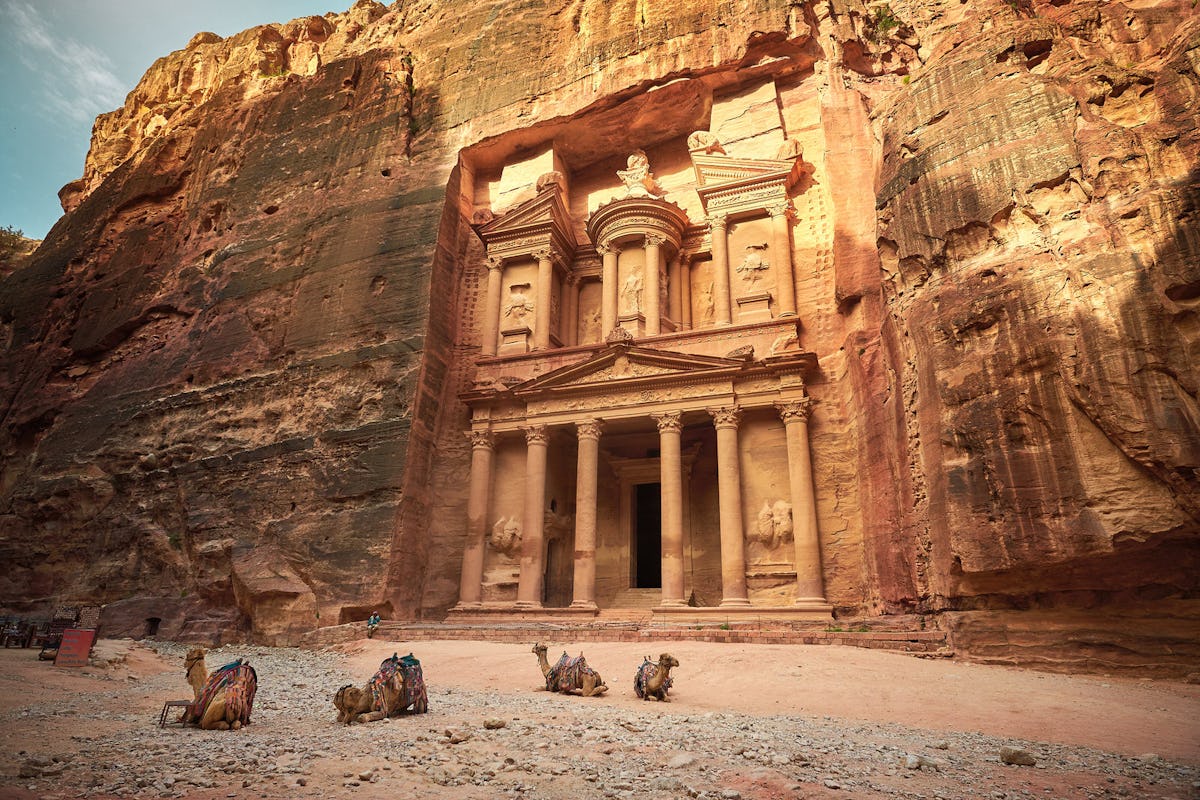
What to See in Petra Jordan
The Treasury
The Treasury is one of Petra, Jordan's most iconic and awe-inspiring structures. Carved directly into the sandstone cliff, it stands tall and majestic, capturing the imagination of visitors worldwide.
The façade of the Treasury features intricate details, with a central entrance leading to a chamber believed to have once housed treasures and riches. The broken pediment, twin gods, and victories add to the grandeur of the structure. It is no wonder that the Treasury is often the first image that comes to mind when thinking about Petra.
As visitors approach the narrow gorge known as the Siq, the sight of the Treasury emerging from the rock is breathtaking. Whether you're a history enthusiast, architecture lover, or traveller seeking adventure, the Treasury is a must-see attraction that will leave you in awe of Petra's ancient craftsmanship and beauty. [13][14]

The Monastery
The Monastery is one of the most awe-inspiring structures in Petra, Jordan. Carved into the sandstone cliffs, this massive monument stands at 45 metres tall and 50 metres wide. It showcases a unique blend of Nabataean and Hellenistic architectural styles.
The facade of The Monastery features a broken pediment, similar to the Treasury, with a central tholos. The interior of The Monastery is said to have been a place of worship, and it has a large flattened space outside for religious ceremonies.
While The Monastery has worn down over time, it retains its grandeur and is a must-visit site in Petra. Exploring this ancient wonder will truly transport you back in time and allow you to marvel at the architectural and cultural brilliance of the Nabataean civilization. [15][16]

The Royal Tombs
The Royal Tombs at Petra, Jordan, are some of the most remarkable architectural marvels in the ancient city. These tombs, sculpted out of the Jabal al-Hubta rock massif's western slope overlook the city centre and showcase the unique artistry of the Nabateans.
The façade of these tombs reflects a blend of Hellenistic and Nabataean architectural styles, with intricate carvings and stunning details. Among the most famous tombs is the Treasury, known for its iconic façade with a central urn, twin gods, and victories. The Monastery, another impressive tomb, stands at a towering height of 45 meters and displays more of a Nabataean influence. The Urn Tomb, Silk Tomb, and Corinthian Tomb are other royal tombs that showcase Petra, Jordan's rich history and culture. Exploring these tombs is like stepping back in time and discovering the ancient world of this lost city. [17][18]
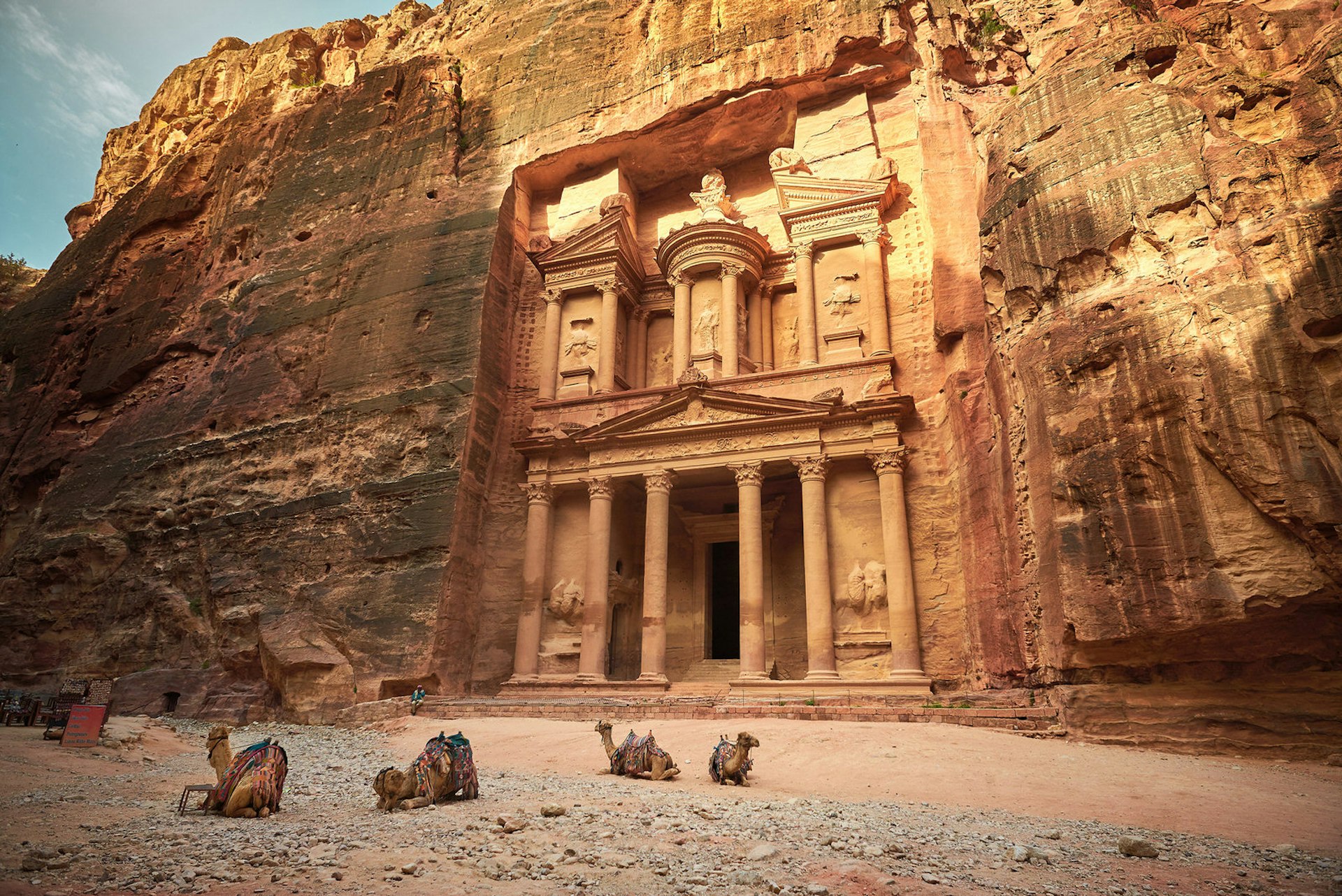
The High Place of Sacrifice
The High Place of Sacrifice is a fascinating and significant site in the ancient city of Petra, Jordan. Situated on top of Jebel Madbah Mountain, it offers breathtaking views and showcases the remarkable rock-cut architecture that Petra is famous for.
This UNESCO World Heritage site was dedicated to the Nabataean gods Dushara and Al 'Uzza, and it is believed that animal sacrifices, libations, and the smoking of frankincense took place here. The High Place of Sacrifice features obelisks carved out of the rock face, a communal supper area, a stone block repository, and a circular altar.
The journey to the High Place is an adventure in itself, taking about 45 minutes of uphill climbing through the crevices and folds of the mountain. From the top, visitors can witness panoramic views of the city, including the tomb of Aaron and the theatre. Despite its dark history, the High Place of Sacrifice is a must-visit for its historical and architectural significance. [19][20]

How to Get to Petra Jordan
By Air
Air is one of the convenient ways to reach Petra, Jordan. The closest airport is the Queen Alia International Airport in Amman, which is well-connected to major cities worldwide. You can book a taxi from the airport or hire a car to drive to Petra, which is approximately a 3-hour journey.
Another option is to take a domestic flight from Amman to Aqaba, closer to Petra, and then travel to Petra by car or bus. However, it's important to note that there are no direct flights to Petra, so you must stop in either Amman or Aqaba.
Flying to Petra allows you to save time and reach the ancient city quickly, so you can start exploring its magnificent wonders. [21][22]

By Car
If you prefer the flexibility and convenience of car travel, it is possible to reach Petra, Jordan, by road. The drive from major cities like Amman or Aqaba will take you through picturesque landscapes, allowing you to soak in the beauty of the Jordanian countryside. The roads in Jordan are well-maintained and easy to navigate, making it a comfortable journey. However, it is recommended to hire a local driver who is familiar with the routes and can provide valuable insights about the region.
Driving to Petra also allows you to explore other attractions, such as the stunning Wadi Rum desert. Just remember that there might be some traffic congestion in certain areas, so it is advisable to plan your itinerary accordingly. With a car, you can have the freedom to stop and explore at your own pace, making it a convenient option for those who prefer more flexibility in their travels. [23][24]

By Bus
Regarding getting to Petra, Jordan, bus travel is convenient and cost-effective. Several bus routes can take you to Petra from various cities in Jordan.
If you plan to travel to Petra from Amman, you can take a local bus or a shared taxi from the Abdali station. The journey takes about three hours, and the bus will drop you off near the entrance of Petra.
Another option is to take a bus from Aqaba, near the Red Sea. The journey takes about two hours, and the bus will also drop you off near the entrance of Petra.
Travelling by bus allows you to sit back, relax, and enjoy the scenic views of the desert as you make your way to Petra. It's a convenient and comfortable way to travel, especially if you're on a budget.
So, if you're looking for an easy and affordable way to get to Petra, consider travelling by bus. It's a great way to experience the beauty of Jordan's desert landscape and arrive at this incredible historic site. [25][26]

Budget Accommodations
When planning a trip to Petra, it's important to consider your budget accommodations. Luckily, plenty of options are available in the town of Wadi Musa, the entry point for Petra. For budget travellers, there are several affordable hotels to choose from. The Petra Moon Hotel and Petra Sella Hotel are top-rated budget options, offering comfortable and affordable accommodation. Infinity Lodge is another great choice, with air-conditioned rooms and free WiFi. If you prefer a unique experience, consider staying at Little Petra Bedouin Camp or Al Nawatef Camp. These eco-friendly camps offer a traditional Bedouin experience and arrange hiking and walking trips upon request. Overall, there are plenty of options for budget accommodations in Wadi Musa, allowing you to explore Petra without breaking the bank. [27][28]

Best Time to Visit Petra Jordan
Weather Conditions
The weather conditions in Petra, Jordan, are characterized by a semi-arid climate. The majority of rainfall occurs during the winter months. The Köppen-Geiger climate classification for Petra is BSk. The average annual temperature in Petra is around 15.5°C (59.9°F). The area receives approximately 193mm (7.60 inches) of precipitation yearly. The unique climate of Petra, with its hot, dry summers and cool winters, adds to the allure of this ancient city. Visitors can expect warm temperatures and clear skies, making it the perfect time to explore the breathtaking ruins and stunning landscapes. Whether you visit during the cooler months or the hotter summer season, Petra offers a captivating experience that will leave a lasting impression. [29][30]
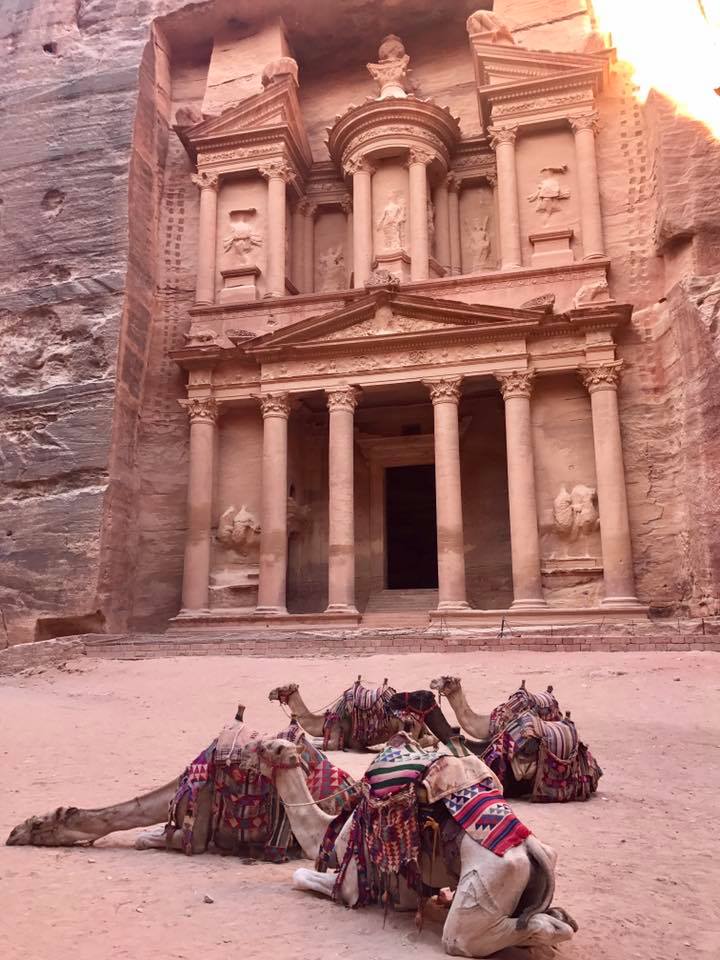
Final Thoughts on Petra Jordan
Petra, Jordan, is a remarkable place steeped in history and beauty. The city's rich history, from its thriving trading centre to its eventual abandonment, adds to its allure. The architectural wonders of Petra, such as the Treasury, the Monastery, the Royal Tombs, and the High Place of Sacrifice, are a testament to the skill and creativity of its ancient builders.
Exploring Petra can be done by air, car, or bus, making it easily accessible to visitors. And for those on a budget, there are options for budget accommodations in the area. It is important to consider the weather conditions when planning a visit to Petra, as certain seasons may be more favourable than others.
Overall, Petra, Jordan, is a must-visit destination for history enthusiasts, adventure seekers, and those who appreciate the beauty of ancient architecture. [31][32]
